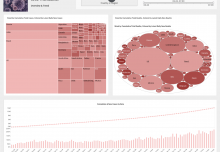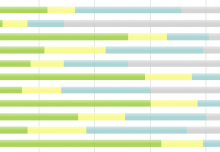If you’ve ever felt like you need a business intelligence platform just to go about choosing the right BI platform, you’re not alone. With countless options on the market and new players frequently entering the space, it can be overwhelming to compare features and pricing to nail down the best one.
You’ll also find that many business intelligence tools make similar product promises with different phrasing, making the process all the more confusing. You can cut through the sales lingo by focusing on the following six BI examples that are essential for choosing a great BI platform:
- Scalability
It takes an investment of time and money to implement a business intelligence solution for your business. With the right platform, you’ll only have to make that investment once. Search for a solution that will scale with your business—not only in terms of your growth, but also in terms of the size of your data and the variety of functions your users will be coming from. Cloud-based solutions, in particular, make it easier to add users and data streams as your needs grow more complex.
- Data Visualization
The brain processes images faster than words and remembers them for longer. That’s why great visualization is critical to understanding and acting on data. A quality BI platform will have a solution for assembling data in a variety of visual ways. Data visualization shouldn’t require a design degree—a good BI platform will make it simple to customize your graphs and charts without support from your engineers or IT department. It should also be simple to share data visualizations across teams since everyone in your organization will react better to a graphic than a spreadsheet.
- Security
Data security is top of mind for leaders in every industry today. It’s also top of mind for consumers. And your BI platform is a treasure trove of important data that you need to keep private. Many BI platforms won’t advertise their security measures in their main list of features, but it’s important to ask about them. Check for proper encryption, password complexity protocols, and access control to ensure you (and your customers) can entrust a BI platform with your most important data.
- Real-Time Data
Traditionally, business intelligence platforms only offered the ability to review and analyze historical data. But in today’s increasingly agile and dynamic world, meeting goals means looking back while moving forward. That’s why excellent BI platforms will combine the ability to review historical data with features that provide access to real-time data. This combines business intelligence with business activity monitoring and makes it possible to make short-term data-based changes as well as long-term innovations.
- Industry Expertise
While most BI platforms are universally applicable to any industry, many have specialities that make them extra qualified for certain verticals. Check for areas of expertise in the BI platforms you’re exploring. If a platform does have a speciality in healthcare, finance, education, or whatever your industry is, you may see increased relevancy in how data is organized and analyzed.
- Customer Support
It may not be a feature that’s inside the platform, but a great BI solution will come will a great support team. Sure, you want easy implementation and intuitive design, but you’re still likely to run into a question or hiccup at some point. Your BI platform will be an integral part of your day-to-day operations so it’s essential the platform you choose is backed by an excellent customer support team. All BI platforms will advertise this, so check out online reviews to find out who’s living up to the promise.
There are many options for BI platform features available. Use this list as a primer to make sure the solution you choose has what it takes to make a real difference in your company’s business intelligence strategy.
Taylor Burke is a contributor for TechnologyAdvice.com. She’s a marketer, storyteller, and techie who loves to learn about and cover business intelligence and other industry topics. When she’s not in front of her screen, you can find Taylor reading, cooking, running, or hanging with her dog—but rarely all four at once. Connect with her on LinkedIn.




